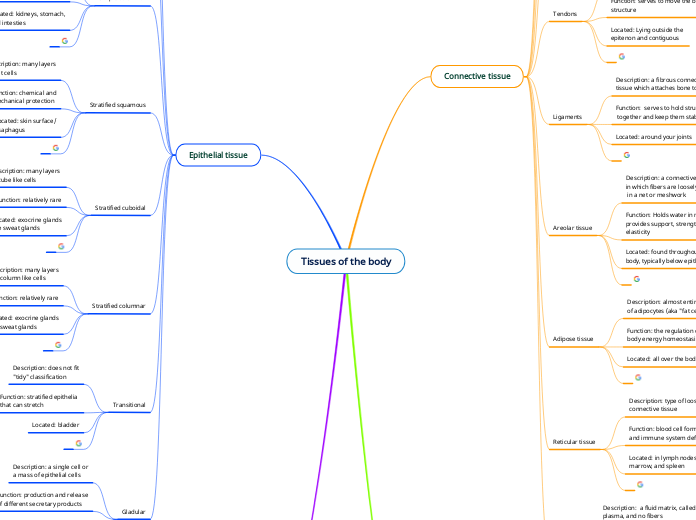Tissues of the body
Epithelial tissue
Simple squamous
Description: single layer of flat
cells of substances.
Function: allows rapid diffusion
of substances.
Located: lungs for gas exchange
Simple cuboidal
Description: single layer of cube-
like cells
Function: involved in secretion
and absorption
Located: kidneys and secretary
glands
Simple columnar
Description: single layer of
column like cells
Function: secretion and
absorption
Located: kidneys, stomach,
and intesties
Stratified squamous
Description: many layers
of flat cells
Function: chemical and
mechanical protection
Located: skin surface/
esaphagus
Stratified cuboidal
Description: many layers
of cube like cells
Function: relatively rare
Located: exocrine glands
like sweat glands
Stratified columnar
Description: many layers
like column like cells
Function: relatively rare
Located: exocrine glands
like sweat glands
Transitional
Description: does not fit
"tidy" classification
Function: stratified epithelia
that can stretch
Located: bladder
Gladular
Description: a single cell or
a mass of epithelial cells
Function: production and release
of different secretary products
Located: a mixture of bone
endocrine (ductless, hormones
are secreted into the blood
Nervous tissue
Neurons
Description: branches or spikes extending
out from the cell body.
Function: send and receive signals.
Located: the brain, spinal cord, and nerves.
Supporting cells
Description: non-neuronal cells
of the nervous system.
Function: maintaining homeostatic
control and immune surveillance in
the nervous system.
Located: the central nervous system
(brain and spinal cord)
Connective tissue
Bone
Description: white and sturdy
Function: protects and supports
body
Located: ends of bone
Hyaline cartilage
Description: pearl gray
semitranslucent matrix
Function: provides mechanical
support for the respiratory tree,
nose, articular surface, and
developing bones.
Located: in the nose, trachea,
larnyx, and bronchi
Fibrocartilage
Description: most tensile
strength
Function: provides the tough
material of the intervertebral discs
Located: found between vertebrae
and knee joint
Elastic cartilage
Description: most springy
Function: provides strength, and elasticity
Located: in external ear and epiglottis
Tendons
Description: fibrous connective tissue
which attaches muscle to bone
Function: serves to move the bone or
structure
Located: Lying outside the
epitenon and contiguous
Ligaments
Description: a fibrous connective
tissue which attaches bone to bone
Function: serves to hold structures
together and keep them stable
Located: around your joints
Areolar tissue
Description: a connective tissue
in which fibers are loosely arranged
in a net or meshwork
Function: Holds water in matrix,
provides support, strength and
elasticity
Located: found throughout the
body, typically below epithelial
Adipose tissue
Description: almost entirely
of adipocytes (aka "fat cell")
Function: the regulation of whole-
body energy homeostasis
Located: all over the body
Reticular tissue
Description: type of loose
connective tissue
Function: blood cell formation
and immune system defenses
Located: in lymph nodes, bone
marrow, and spleen
Blood
Description: a fluid matrix, called
plasma, and no fibers
Function: transportation, regulation,
and protection
Located: inside the blood vessels
Muscle tissue
Skeletal muscle
Description: long and thin,
multi-nucleated, striated.
Function: pulls on bones to make
gross body movements or
cause changes in facial movements.
Located: attached to bones.
Cardiac muscle
Description: much shorter,
uni-nucleated, striated, fit close
together at junctions called
"intercalated discs"
Function: must generate ATP
continuously.
Located: heart
Smooth muscle
Description: smooth like, spindle
like, not cylindrical, uni-nucleated,
not striated.
Function: propels substances,
slower (ex. Peristalsis)
Located: walls of hallow organs.
